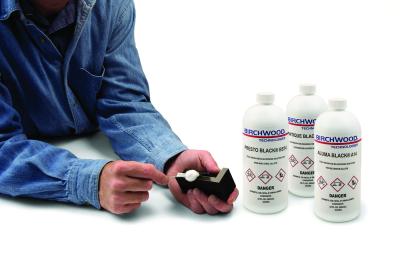
Birchwood Technologies three brush-on metal blackeners—Presto Black BST4, Antique Black M24, and Aluma Black A14—are now available in smaller, quart sized (32 oz.) bottles for easier application and handling, at a new lower price point.
Ideal for most iron and steel components, Presto Black BST4 Brush-On is for application on any size part in limited quantities. It solves the application challenges of immersion liquid products while producing an attractive, high quality, durable black finish. Can be sealed easily with a rust-preventative for extra finish protection.
Antique Black M24 Brush-On provides blackening or browning of brass, bronze and copper alloys. It produces pleasing US10B finishes on large architectural surfaces, sculptures and engravings, either new or reconditioned components. Reaction speed and finish color is easily controlled by diluting the concentrate with water. Can be used undiluted for darker finishes or diluted 1-50 percent for slower reactions and lighter, brown tones.
Designed just for aluminum alloys, Aluma Black A14 Brush-On provides a durable, smooth black finish. Easily applied undiluted to blacken entire parts or use as a touch-up for black anodized parts that have been damaged or re-machined. Ideal for all types of aluminum parts including engravings.
Contact Details
Related Glossary Terms
- alloys
alloys
Substances having metallic properties and being composed of two or more chemical elements of which at least one is a metal.
- aluminum alloys
aluminum alloys
Aluminum containing specified quantities of alloying elements added to obtain the necessary mechanical and physical properties. Aluminum alloys are divided into two categories: wrought compositions and casting compositions. Some compositions may contain up to 10 alloying elements, but only one or two are the main alloying elements, such as copper, manganese, silicon, magnesium, zinc or tin.
- copper alloys
copper alloys
Copper containing specified quantities of alloying elements added to obtain the necessary mechanical and physical properties. The most common copper alloys are divided into six groups, and each group contains one of the following major alloying elements: brasses—major alloying element is zinc; phosphor bronzes—major alloying element is tin; aluminum bronzes—major alloying element is aluminum; silicon bronzes—major alloying element is silicon; copper-nickels and nickel-silvers—major alloying element is nickel; and dilute-copper or high-copper alloys, which contain small amounts of various elements such as beryllium, cadmium, chromium or iron.
